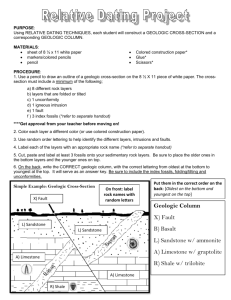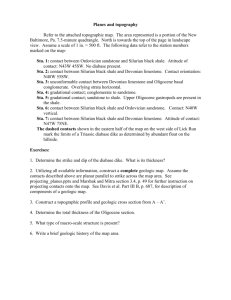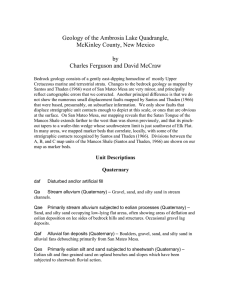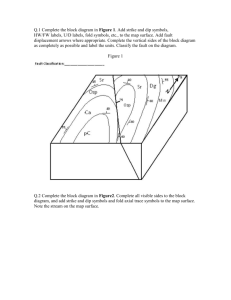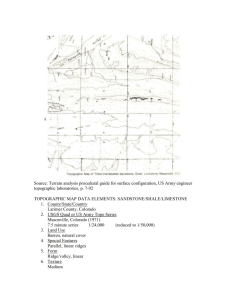Document 10907273
advertisement
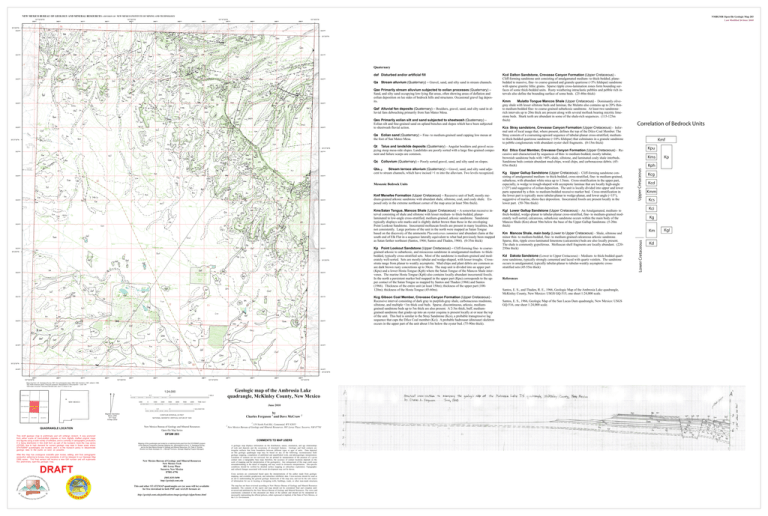
NEW MEXICO BUREAU OF GEOLOGY AND MINERAL RESOURCES A DIVISION OF NEW MEXICO INSTITUTE OF MINING AND TECHNOLOGY 107°52'30"W 239000 240000 241000 107°50'0"W 242000 243000 244000 245000 107°47'30"W 246000 247000 248000 249000 250000 NMBGMR Open-file Geologic Map 203 Last Modified 24 June 2010 107°45'0"W 35°30'0"N 3932000 3932000 35°30'0"N 3931000 3931000 Quaternary daf Disturbed and/or artificial fill 3930000 3930000 3929000 3929000 Qa Stream alluvium (Quaternary) – Gravel, sand, and silty sand in stream channels. Qae Primarily stream alluvium subjected to eolian processes (Quaternary) – Sand, and silty sand occupying low-lying flat areas, often showing areas of deflation and eolian deposition on lee sides of bedrock hills and structures. Occasional gravel lag deposits. Qaf Alluvial fan deposits (Quaternary) – Boulders, gravel, sand, and silty sand in alluvial fans debouching primarily from San Mateo Mesa. 3928000 3928000 Qes Primarily eolian silt and sand subjected to sheetwash (Quaternary) – Eolian silt and fine-grained sand on upland benches and slopes which have been subjected to sheetwash fluvial action. Qe Eolian sand (Quaternary) – Fine- to medium-grained sand capping low mesas at the foot of San Mateo Mesa. 35°27'30"N 35°27'30"N 3927000 3927000 Qt Talus and landslide deposits (Quaternary) – Angular boulders and gravel occupying steep mesa-side slopes. Landslides are poorly sorted with a large fine-grained component and failure scarps are common. Qc Colluvium (Quaternary) – Poorly sorted gravel, sand, and silty sand on slopes. Stream terrace alluvium (Quaternary) – Gravel, sand, and silty sand adjaQta1-2 cent to stream channels, which have incised >1 m into the alluvium. Two levels recognized. 3926000 3926000 Mesozoic Bedrock Units 3925000 3925000 3924000 3924000 3923000 3923000 35°25'0"N 35°25'0"N 3922000 3922000 3921000 3921000 3920000 3920000 3919000 3919000 35°22'30"N 3918000 3918000 35°22'30"N 239000 240000 107°52'30"W 241000 242000 107°50'0"W 243000 244000 245000 246000 107°47'30"W 247000 Base map from U.S. Geological Survey 1957, from photographs taken 1956, field checked in 1957, edited in 1980. 1927 North American datum, Polyconic projection, Reprojected to UTM projection -- zone 13N 1000-meter Universal Transverse Mercator grid, zone 13, shown in red 1 1000 NEW MEXICO GOAT MOUNTAIN BLUEWATER Ambrosia AMBROSIA LAKE Lake DOS LOMAS 0.5 0 0 1000 2000 3000 1 MILE 4000 5000 6000 7000 FEET SAN MATEO Magnetic Declination March, 2008 10º 7' East At Map Center 0.5 0 250000 107°45'0"W June 2010 SAN LUCAS DAM 1 249000 Geologic map of the Ambrosia Lake quadrangle, McKinley County, New Mexico 1:24,000 BORREGO PASS 248000 1 KILOMETER by Charles Ferguson and Dave McCraw 2 1 CONTOUR INTERVAL 20 FEET NATIONAL GEODETIC VERTICAL DATUM OF 1929 1 QUADRANGLE LOCATION This draft geologic map is preliminary and will undergo revision. It was produced from either scans of hand-drafted originals or from digitally drafted original maps and figures using a wide variety of software, and is currently in cartographic production. It is being distributed in this draft form as part of the bureau's Open-file map series (OFGM), due to high demand for current geologic map data in these areas where STATEMAP quadrangles are located, and it is the bureau's policy to disseminate geologic data to the public as soon as possible. After this map has undergone scientific peer review, editing, and final cartographic production adhering to bureau map standards, it will be released in our Geologic Map (GM) series. This final version will receive a new GM number and will supercede this preliminary open-file geologic map. DRAFT New Mexico Bureau of Geology and Mineral Resources Open-file Map Series 2 119 North Fork Rd., Centennial, WY 82055 New Mexico Bureau of Geology and Mineral Resources, 801 Leroy Place, Socorro, NM 87701 OFGM 203 COMMENTS TO MAP USERS Mapping of this quadrangle was funded by a matching-funds grant from the STATEMAP program of the National Cooperative Geologic Mapping Act, administered by the U. S. Geological Survey, and by the New Mexico Bureau of Geology and Mineral Resources, (Dr. Peter A. Scholle, Director and State Geologist, Dr. J. Michael Timmons, Geologic Mapping Program Manager). New Mexico Bureau of Geology and Mineral Resources New Mexico Tech 801 Leroy Place Socorro, New Mexico 87801-4796 [505] 835-5490 http://geoinfo.nmt.edu This and other STATEMAP quadrangles are (or soon will be) available for free download in both PDF and ArcGIS formats at: http://geoinfo.nmt.edu/publications/maps/geologic/ofgm/home.html A geologic map displays information on the distribution, nature, orientation, and age relationships of rock and deposits and the occurrence of structural features. Geologic and fault contacts are irregular surfaces that form boundaries between different types or ages of units. Data depicted on this geologic quadrangle map may be based on any of the following: reconnaissance field geologic mapping, compilation of published and unpublished work, and photogeologic interpretation. Locations of contacts are not surveyed, but are plotted by interpretation of the position of a given contact onto a topographic base map; therefore, the accuracy of contact locations depends on the scale of mapping and the interpretation of the geologist(s). Any enlargement of this map could cause misunderstanding in the detail of mapping and may result in erroneous interpretations. Site-specific conditions should be verified by detailed surface mapping or subsurface exploration. Topographic and cultural changes associated with recent development may not be shown. Cross sections are constructed based upon the interpretations of the author made from geologic mapping, and available geophysical, and subsurface (drillhole) data. Cross-sections should be used as an aid to understanding the general geologic framework of the map area, and not be the sole source of information for use in locating or designing wells, buildings, roads, or other man-made structures. The map has not been reviewed according to New Mexico Bureau of Geology and Mineral Resources standards. The contents of the report and map should not be considered final and complete until reviewed and published by the New Mexico Bureau of Geology and Mineral Resources. The views and conclusions contained in this document are those of the authors and should not be interpreted as necessarily representing the official policies, either expressed or implied, of the State of New Mexico, or the U.S. Government. Kmf Menefee Formation (Upper Cretaceous) – Recessive unit of buff, mostly medium-grained arkosic sandstone with abundant shale, siltstone, coal, and coaly shale. Exposed only in the extreme northeast corner of the map area (at least 50m thick). Kms Satan Tongue, Mancos Shale (Upper Cretaceous) – A somewhat recessive interval consisting of shale and siltstone with lesser medium- to thick-bedded, planarlaminated to low-angle cross-stratified, medium-grained, arkosic sandstone. Sandstone typically displays sole marks and is slightly darker brown than those in the enveloping Point Lookout Sandstone. Inoceramid molluscan fossils are present in many localities, but not consistently. Large portions of the unit in the north were mapped as Satan Tongue based on the discovery of the ammonite Placenticeras cumminsi and abundant clams at the south end of Elk Flat in a sequence laterally equivalent to what had previously been mapped as Satan farther northeast (Santos, 1966; Santos and Thaden, 1966). (0-35m thick) Kp Point Lookout Sandstone (Upper Cretaceous) – Cliff-forming fine- to coarsegrained arkosic to subarkosic, and micaceous sandstone in amalgamated medium- to thickbedded, typically cross-stratified sets. Most of the sandstone is medium-grained and moderately well-sorted. Sets are mostly tabular and wedge-shaped, with lesser troughs. Crossstrata range from planar to weakly asymptotic. Mud-chips and plant debris are common as are dark brown rusty concretions up to 30cm. The map unit is divided into an upper part (Kpu) and a lower Hosta Tongue (Kph) where the Satan Tongue of the Mancos Shale intervenes. The marine Hosta Tongue (Kph) also contains locally abundant inoceramid fossils. In the north a persistent marker bed mapped in the upper part (Kpu) corresponds to the upper contact of the Satan Tongue as mapped by Santos and Thaden (1966) and Santos (1966). Thickness of the entire unit (at least 150m); thickness of the upper part (100120m); thickness of the Hosta Tongue (45-60m). Kcg Gibson Coal Member, Crevasse Canyon Formation (Upper Cretaceous) Recessive interval consisting of dark gray to purplish-gray shale, carbonaceous mudstone, siltstone, and multiple <1m thick coal beds. Sparse, discontinuous, arkosic, mediumgrained sandstone beds up to 5m thick are also present. A 2-3m thick, buff, mediumgrained sandstone that grades up into an oyster coquina is present locally at or near the top of the unit. This bed is similar to the Stray Sandstone (Kcs), a probable transgressive lag sequence that caps the Dilco Coal member (Kci). A probable hadrosaur (dinosaur) skeleton occurs in the upper part of the unit about 15m below the oyster bed. (75-90m thick). Kcd Dalton Sandstone, Crevasse Canyon Formation (Upper Cretaceous) Cliff-forming sandstone unit consisting of amalgamated medium- to thick-bedded, planebedded to massive, fine- to coarse-grained and granule quartzose (<5% feldspar) sandstone with sparse granitic lithic grains. Sparse ripple cross-lamination zones form bounding surfaces of some thick-bedded units. Rusty weathering intraclastic pebbles and pebble rich intervals also define the bounding surface of some beds. (25-40m thick) Kmm Mulatto Tongue Mancos Shale (Upper Cretaceous) - Dominantly olivegray shale with lesser siltstone beds and laminae, the Mulatto also contains up to 20% thinto medium-bedded fine- to coarse-grained subarkosic sandstone. At least two sandstonerich intervals up to 20m thick are present along with several mollusk bearing micritic limestone beds. Shark teeth are abundant in some of the shale-rich sequences. (115-125m thick) Kcs Stray sandstone, Crevasse Canyon Formation (Upper Cretaceous) - Informal unit of local usage that, where present, defines the top of the Dilco Coal Member. The Stray consists of a coarsening-upward sequence of tabular-planar cross-stratified, mediumto thick-bedded quartzose sandstone (<10% feldspar) that culminates in a granule sandstone to pebble conglomerate with abundant oyster shell fragments. (0-15m thick) Kci Dilco Coal Member, Crevasse Canyon Formation (Upper Cretaceous) - Recessive unit characterized by sequences of thin- to medium-bedded, mostly tabular, brownish sandstone beds with >40% shale, siltstone, and laminated coaly shale interbeds. Sandstone beds contain abundant mud-chips, wood chips, and carbonaceous debris. (4565m thick) Kg Upper Gallup Sandstone (Upper Cretaceous) - Cliff-forming sandstone consisting of amalgamated medium- to thick-bedded, cross-stratified, fine- to medium-grained, subarkose, with abundant white mica up to 1.5mm. Cross-stratification in the upper part, especially, is wedge to trough-shaped with asymptotic laminae that are locally high-angle (>25°) and suggestive of eolian deposition. The unit is locally divided into upper and lower parts separated by a thin- to medium-bedded recessive marker bed. Cross-stratification in the lower part is typically more tabular-planar to wedge-planar, and lower angle (<15°), suggestive of marine, shore-face deposition. Inoceramid fossils are present locally in the lower part. (50-70m thick) Kgl Lower Gallup Sandstone (Upper Cretaceous) - An Amalgamated, medium- to thick-bedded, wedge-planar to tabular-planar cross-stratified, fine- to medium-grained moderately well-sorted, calcareous, subarkosic sandstone occurs within the main body of the Mancos Shale (Km) about 50m below the base of the Upper Gallup Sandstone. (5-20m thick) Km Mancos Shale, main body (Lower to Upper Cretaceous) – Shale, siltstone and minor thin- to medium-bedded, fine- to medium-grained calcareous arkosic sandstone. Sparse, thin, ripple cross-laminated limestone (calcarenite) beds are also locally present. The shale is commonly gypsiferous. Molluscan shell fragments are locally abundant. (220250m thick) Kd Dakota Sandstone (Lower to Upper Cretaceous) – Medium- to thick-bedded quartzose sandstone, typically strongly cemented and laced with quartz veinlets. The sandstone occurs in amalgamated, typically tabular-planar to tabular-weakly asymptotic crossstratified sets (45-55m thick) References Santos, E. S., and Thaden, R. E., 1966, Geologic Map of the Ambrosia Lake quadrangle, McKinley County, New Mexico: USGS GQ-515, one sheet 1:24,000 scale. Santos, E. S., 1966, Geologic Map of the San Lucas Dam quadrangle, New Mexico: USGS GQ-516, one sheet 1:24,000 scale.

